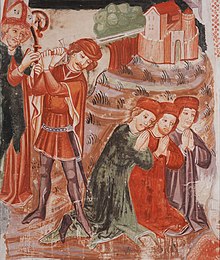
Johannes of Ljubljana (Latin: Johannes de Laybaco, Slovenized as Janez Ljubljanski), was a painter active between 1433 and 1460.
Life and work
Johannes was the son of Frederic of Villach, and he became a citizen of the town of Ljubljana around 1440. He initially worked in his father's workshop in Carinthia, where he created his first independent works. He is believed to have had close contact with the Cistercians, and in Carniola he worked on commissions from Stična Abbey. His bet-known signed and dated frescoes are in the Gothic Saint Nicholas's Church in Visoko (1443) and in Muljava (1456). A work of his bearing only a date (1459) is found in Saint Peter's Church in Kamni Vrh pri Ambrusu. His independent works also include paintings at the monastery in Stična and at the churches in Metnaj and Mačkovec pri Dvoru, and together with painters from his workshop he also created works in Troščine and at Saint Nicholas's Chapel of Ease in Žužemberk. Products of his workshop are also considered the frescoes in Mengeš and the pilgrimage church dedicated to the Annunciation in Crngrob, where he painted Holy Sunday around 1460.
Johannes brought a late soft style of painting to Carniola from Carinthia, pervaded by Bohemian and Italian influences. His works are characterized by the skill of his workshop, their colorful plastic modeling, idealized calm, and the beauty of the figures. With regard to his iconography, his work shows some adaptation to the painting style common to Carniolan chancels.
References
- Campbell, Gordon (2009). The Grove Encyclopedia of Northern Renaissance Art. Oxford: Oxford University Press. p. 274.
- Hourihane, Colum (2012). The Grove Encyclopedia of Medieval Art and Architecture. New York: Oxford University Press. p. 625.
- Turner, Jane (2005). The Dictionary of Art, vol. 16. New York: Grove. p. 494.
- Križnar, Anabelle (2014). "A Comparative Study of Wall Painting Materials and Techniques Used in Fifteenth Century Austria by Frederich of Villach and His Followers". Studies in Conservation. 59 (5): 289–299. doi:10.1179/2047058413Y.0000000114. S2CID 193207496. Retrieved April 22, 2020.
- Križnar, Anabelle (2014). "Plasters in Mediaeval Mural Paintings of Carinthia and Their Influence on Slovenia". Journal of Architectural Conservation. 20 (1): 43–55. doi:10.1080/13556207.2014.886375. S2CID 194030446. Retrieved April 22, 2020.
- ^ Rozman, Ksenija (1990). "Janez Ljubljanski". Enciklopedija Slovenije. Vol. 4. Ljubljana: Mladinska knjiga. pp. 263–264.